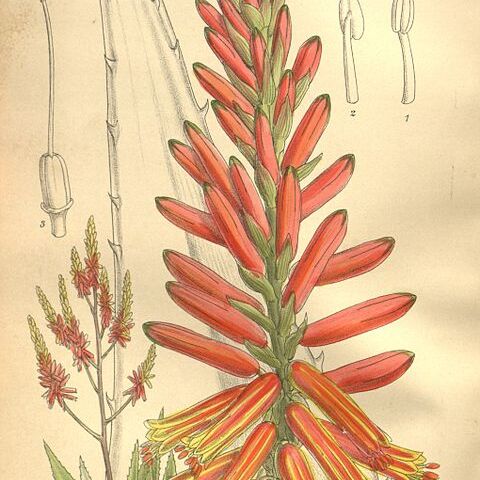Plants solitary, developing a simple stem up to 3 met., the stem densely bearded with old dried persistent leaves. Leaves many, densely rosulate, arcuate-erect, slightly recurved, with the oldest leaves spreading downwards, lanceolate-ensiform, gradually acuminate, about 60 cm long, about 11 cm broad at base; upper surface flat low down, slightly canaliculate upwards, greyish-green, sometimes with a reddish tinge, sometimes immaculate, or with few or many elongated large white spots usually more copiously spotted in lower third, fewer upwards; lower surface convex, without spots, or sometimes with few to many large white spots, usually more copiously spotted than the upper; margins armed with stout deltoid brown to reddish-brown teeth which spring from a dirty white base, about 5 mm long, more crowded near base (6 mm apart) more distant (about 10-20 mm apart) upwards. Inflorescence a many-branched panicle, branched low down, 1 met. tall, sometimes 2 consecutively. Racemes erect, narrowly cylindric-acuminate, sub-densely flowered, the terminal about 35 cm long, the lateral slightly shorter, 1 cm diam. at apex, 7 cm diam. low down, the apical buds obscured by their longer densely imbricate bracts, gradually slightly laxer downwards, with the lowest open flowers about 20 mm apart. Bracts lanceolate-to ovate-acuminate, usually reflexed at the middle, about 15 mm long, 7-8 mm broad, very thin, scarious, white, many-nerved. Pedicels shorter than the bracts, the lowest 6-10 mm long, shorter upwards. Perianth cylindric-trigonous, basally rounded or very slightly stipitate, very slightly enlarging towards the throat, about 30 mm long, dull rose-red to bright red, turning yellowish at mouth; outer segments free to the middle (or beyond), obscurely many-nerved, with pale marginal border and straight apices; inner segments themselves free but dorsally adnate to the outer for half their length, with a pronounced keel the colour of the perianth, the apices somewhat brownish, slightly spreading, more obtuse than the outer. Filaments filiform-flattened, almost white, the 3 inner narrower and lengthening in advance of the 3 outer, with their anthers in turn exserted up to 5 mm Style filiform, pale lemon, with the stigma at length exserted 7 mm and remaining exserted after pollination. Ovary 8 mm long, 3 mm diam., finely 6-grooved, green. Capsule cylindric-broadly trigonous, about 25 mm long, 11 mm diam. at the middle. It appears that plants flower in their various geographical stations at different times, probably depending on the rains. In South West Africa, in the far north of the territory July-August appears to be the flowering time, and January in the Auob Valley. May is also recorded for another locality, while the Zoutpansberg form flowers in February-March, plants usually being in seed by April.
More
Trees; stems solitary, 2-4 m tall. Leaves 30-40, arcuate-erect to slightly reflexed, 300-650 x 65-130 mm, shallowly channelled, greyish green to yellowish green, sometimes tinged reddish, usually unspotted, rarely with white spots, without prickles. Inflorescence of conical, sublax racemes; many-branched, 1.0-1.5 m tall; bracts lanceolate-acuminate, 9-18 x 4-8 mm, 5-many-nerved. Flowers red or pink, rarely yellow, 23-34 mm long, cylindric-trigonous; outer segments connate in lower half, inner segments free but adnate to outer in lower half; pedicels 6-12 mm long. Anthers exserted 1-5 mm. Ovary 5.0-8.0 x 2.5-4.0 mm, olive-green; style exserted 2-10 mm. Fruit 18-28 x 10-15 mm, grey. Seeds ±9.0 x 4.0 x 1.5 mm, charcoal-grey, with broad, pale grey, dark-spotted wing. Flowering time July to February, varying according to locality.
A plant with a single stem. It grows to 3.5 m high. It is densely covered with old dry leaves along the trunk. The leaves are erect and greyish-green. The edges of the leaves have sharp light brown teeth. The flower heads are branched. The flowers are in dense pointed spikes. They are rose-red and the tips turn yellow.
Arborescent succulent, up to 4 m high. Leaves unmarked, old dead leaves persistent. Inflorescence many-branched, 1.0-1.5 m high. Racemes erect, numerous, laxly flowered. Flowers red or pink, rarely yellow.


